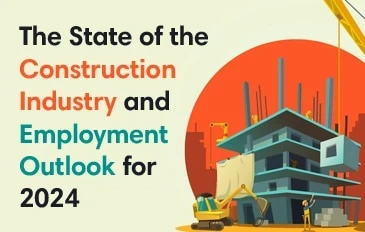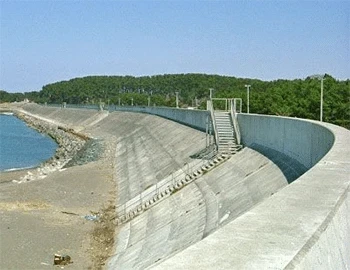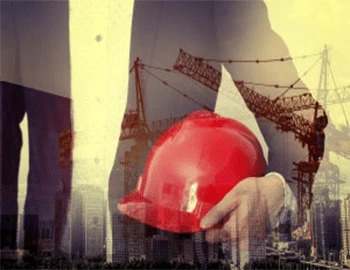The State of The Construction Industry: Employment Outlook 2024

The State of the Construction Industry and Employment Outlook for 2024
The construction industry is a vital economic sector that plays a significant role in economic growth and development. As we look ahead to 2024, it is crucial to assess the current state of the construction industry and explore the employment outlook for the coming year. This blog post will delve into the key trends, challenges, and opportunities shaping the construction industry, as well as the factors that will influence employment prospects in 2024
1. Growth and Economic Impact: The construction industry has experienced steady growth in recent years, contributing to economic prosperity and job creation. In 2024, the industry is expected to continue its upward trajectory, driven by several factors. One significant driver is increased infrastructure spending by governments worldwide to address aging infrastructure and support economic recovery post-pandemic. Additionally, population growth, urbanization, and the demand for sustainable and energy-efficient buildings will fuel construction activities.
2. Technological Advancements: The construction industry is undergoing a digital transformation, embracing advanced technologies that enhance efficiency, safety, and productivity. Building Information Modeling (BIM), robotics, drones, and augmented reality are revolutionizing construction processes, enabling faster and more accurate project delivery. The integration of Internet of Things (IoT) devices in construction sites improves data collection and analysis, enabling proactive decision-making and reducing costs. As technology continues to evolve, construction companies that adapt and leverage these advancements will have a competitive advantage in attracting skilled professionals.
3. Workforce Challenges: The construction industry faces a significant challenge related to the aging workforce. Many experienced professionals are approaching retirement age, creating a skills gap that needs to be filled by new talent. The industry must focus on attracting younger generations and promoting careers in construction through apprenticeships, vocational training programs, and educational partnerships. Moreover, diversity and inclusion efforts should be prioritized to ensure a more inclusive and representative workforce.
4. Green Construction and Sustainability: Sustainability has become a critical consideration in the construction industry. The demand for environmentally friendly and energy-efficient buildings continues to grow. With increasing emphasis on reducing carbon emissions and promoting sustainable practices, construction companies must adapt to meet these expectations. This shift towards green construction offers opportunities for skilled professionals specializing in sustainable design, renewable energy integration, and green building certifications.
5. Employment Outlook for 2024: Looking ahead to 2024, the employment outlook in the construction industry appears promising. The demand for construction workers, including architects, engineers, project managers, skilled tradespeople, and construction laborers, is expected to remain strong. The ongoing infrastructure projects, urban development initiatives, and sustainable construction practices will drive job opportunities across various sectors.
However, the availability of a skilled workforce will be a critical factor in meeting industry demands. Companies that invest in training and development programs, mentorship, and apprenticeship initiatives will have a competitive advantage in attracting and retaining top talent.
Additionally, the integration of technology will reshape job roles in the construction industry. Professionals with expertise in digital construction tools, data analysis, and automation will be in high demand. Collaborative and interdisciplinary skills, along with adaptability to technological advancements, will be essential for future construction professionals.
In conclusion, the construction industry is poised for growth and transformation in 2024. With increased infrastructure spending, technological advancements, sustainable construction practices, and a strong demand for skilled professionals, the employment outlook remains positive. However, addressing workforce challenges, promoting diversity and inclusion, and adapting to changing technologies will be crucial for construction companies to thrive in the evolving landscape. By staying abreast of industry trends and investing in talent development, the construction sector can continue to drive economic growth while providing rewarding career opportunities for professionals in the coming year.
Michael DeSafey is a leading executive recruiter for professionals in the construction, engineering, and environmental industries. He is currently the President of Webuild Staffing: www.webuildstaffing.com. To learn more about Michael, or to follow his blog, please visit www.michaeldesafey.com.
Environmental Construction: 3 Functions of a Seawal

Environmental Construction: 3 Functions of a Seawall
If you’ve ever been to a coastal town, chances are good you’ve noticed they have a seawall. Sometimes they’re big and impressive, sometimes they’re smaller and more subtle, but they’re a common sight wherever the land meets the water. Those who don’t live near the coast, and who don’t have to deal with the moods of the ocean, may wonder why these seawalls are necessary, and why humans have been building them for literally thousands of years, now.
Well, a seawall serves multiple functions, and they’re one of the best methods we’ve found for getting the results we want. For example…
#1: Storm Protection
When severe weather begins ramping up, the coast is where the beating falls first. From gale force winds to full-on hurricanes, the normal, gentle waves can quickly be whipped into a hammer that can destroy buildings, wreck roads, and cause all sorts of damage. This kind of weather can also lead to flooding, both mild and severe. A seawall acts as a shield, preventing at least some of this force from making landfall, and diluting the blows of severe weather to help protect the community living on land.
This is also why different communities have different seawall designs. Seawalls may be curved, they may be in a stepped design, or they may have other, unique features. Sometimes they’re placed up on the land itself, sometimes they’re at the water’s edge, and sometimes they’re actually placed further out in the water, providing a break that protects both the land and a section of the water (often a bay, beach, or some other place where there tends to be a lot of traffic). These are often made with the weather patterns in mind, ensuring the seawall can do its job and weather the storms, according to Wise Geek.
#2: Erosion Control
Even when waves haven’t been whipped into a frenzy by inclement weather, they can still damage the coastline. Erosion is a real problem, and the more powerful the waves get, the bigger a problem it becomes. A seawall helps take some of the sting out of waves, ensuring that beaches, hills, and other coastal areas are preserved against this kind of damage as long as possible. In many coastal areas where conservation and reinvigorating the local wilderness are top priorities, seawalls are one of the best tools available.
Erosion is not just a beach concern, either. Docks and piers can also expect to see long-term damage from exposure to waves that individually were seen as harmless. A seawall prevents this damage, as well, allowing these other constructions to last longer than they would if they were simply left on their own to weather their contact with the ebb and flow of the water.
#3: Safer Waterways
In addition to protecting harbors, beaches, and land, seawalls also provide cover and safety for smaller waterways. This can be particularly important during periods of stormy weather, when everyone is trying to get safely away from open water. Even if the boats in question don’t have a regular berth in a particular waterway, protecting the access points provides safe havens, and helps avoid clogging caused by too many boats coming in too quickly.
As long as a sea wall provides a buffer between a waterway and the churning waves of the open water, it’s performing a vital function. Giving vessels breathing room to maneuver, find safety, and avoid damaging themselves, each other, and any land they might otherwise run afoul of is a particularly helpful use of these walls in communities where there are a number of personal (or even commercial) vessels.
Strong Walls Need Dedicated Professionals
Coastal real estate is always going to be in-demand, and as long as people live near the water there’s going to be a need for strong seawalls to help keep them and their homes safe. Civil engineers, construction professionals, structural engineers, and others are all requires to build these walls, install them, and maintain them against the ravages of time, and the pounding surf.
Even the strongest shield needs to be replaced from time to time, meaning that as long as there are people living within sight of the coast, there’s going to be a seawall somewhere that needs the attention of professionals to ensure it’s capable of serving its purpose.
Michael DeSafey is a leading executive recruiter for professionals in the construction, engineering and environmental industries. He is currently the President of Webuild Staffing www.webuildstaffing.com . To learn more about Michael or to follow his blog please visit www.michaeldesafey.com
10 Things To Avoid Saying In A Performance Review Working For A Construction, Engineering or Environmental Firm

10 Things To Avoid Saying In A Performance Review Working For A Construction, Engineering or Environmental Firm
A performance review allows an opportunity for construction, engineering or environmental companies to discuss how well their employees are doing in a one-on-one situation. It is the perfect time for them to make suggestions on how jobs could be done better, and employees are often offered a chance to voice any complaints or suggestions also.
Performance reviews are typically carried out either quarterly, semi-annually, or annually. Sometimes they might be completed after a construction or engineering project.
These reviews are the driving forces between whether someone gets a promotion or pay raise and strongly contribute when companies decide to downsize.
One way many workers slip up is through what is said. Often, employees wouldn’t even be able to cite what it was they said wrong. To ensure this doesn’t stand in the way of growing your own career you will want to avoid saying things that reflect badly on you during the performance review.
10 Things to Never Say During Employment Review and Why:
1: “It isn’t my fault.”
While it can be difficult to accept blame, it is also vital to do so if you want to get anywhere in life. Telling your manager something isn’t your fault will only deter them from putting you in any leadership position
2: “I didn’t know.”
Not knowing something is never a valid excuse in the workplace. In these industries specifically, it can be dangerous for “unknowing” people to be on site. This simple phrase can make you appear to not only lack common sense but also to be a liability. If you truly do not know or understand, just ask someone!
3: “But so-and-so did it.”
Never compare yourself to others. Each person is unique in their job descriptions, capabilities, etc. This statement makes you appear more a follower than a leader and will greatly restrict your potential towards career growth.
4: “This isn’t fair.”
Suffice to say, life is not fair. Stating this will make you appear immature or childlike which is obviously not something employers in such high demand industries seek out in potential employees.
5: “Thanks, but I didn’t really do anything,” or “It was really a team effort.”
Many people feel uncomfortable when taking praise but when you’ve done a good job it’s okay to simply say thank you. Failure to accept praise is nearly as bad as an inability to accept criticism.
6: “Can I get a raise?”
While performance reviews are the place to get a raise, they are NOT the place to ask for one. Instead of asking for one outright, show your employer why you deserve one.
7: “That is not part of my job description.”
Anything your foreman, manager, or supervisor asks you to do is part of your job description. It takes everyone on site working as a team to effectively get the job done. The only exception for the construction, engineering, and environmental industries is if the task requires certifications or school you do not possess.
8: “I know.”
When your employer or manager tells you something, do not respond with “I know.” This can get irritating and makes you appear smug.
9: “But I’m not good at that,” or “That is not my strong point.”
You may not be good at whatever it is, but stating the obvious makes it appear as though you are not open to growth. Instead try saying, “I will work on that,” or “I will make an effort to improve on those skills.”
10: “This evaluation is wrong.”
Never tell your evaluator that they are wrong. Do not threaten to file a rebuttal. If you received a poor review you should look at it as an opportunity for growth. Simply thank your evaluator and walk out with your head high, determined to move forward with their suggestions.
Michael DeSafey is a leading executive recruiter for professionals in the construction, engineering and environmental industries. He is currently the President of Webuild Staffing www.webuildstaffing.com . To learn more about Michael or to follow his blog please visit www.michaeldesafey.com
The Key to Getting the Job You Want

The Key to Getting the Job You Want
Many employees find themselves walking a fine line. They want a new position: to move into a job that takes better advantage of their skills, to attain a promotion within their existing job, or even to move to a different place of employment. When you have your eye on a specific position, you want to do everything in your power to get it. There’s one secret to the process: assertiveness. While you don’t want to be overbearing or appear that you’re trying to force your way into a position–particularly with an existing employer–you do want to be sure that you’re being clear and assertive about your plans.
1.Make your goals clear. If you’re content in your current position and don’t want further responsibility, it’s all right to say so. On the other hand, if you want something more, make sure that your employer knows it! There’s no need to be rude; simply
putting the information out there is more than enough. For example, you might say, “I would eventually like to be a construction foreman, and I’d like the opportunity to develop leadership skills within my current position.” If your current employer doesn’t know that you want to move up, you may miss out on valuable opportunities. When you’re looking to move to a new company, share why you’re interested in them: “I love your company’s vision, and all of my interactions with the company have shown that your culture would be a great fit for me.” Your employer can’t read your mind. By clearly sharing exactly what is that you want, you’ll discover that they’re more likely to give it to you.
2.Follow the application process. Whether you’re hoping to move up from within or you’re looking for a new job, it’s important to follow the described application process to the letter. Take a good look at even the most unusual or obscure instructions in the application process. Hiring managers at a new company take note of the details: if they tell you to send your information by email, do so. If they ask for a hard copy of your resume, it’s important to provide it. When you pay attention to the details of the application, you show that you’re genuinely interested in a specific job, not just following the same procedure for every application you put in–and you prove that you’ll give that same attention to detail in your everyday job performance.
3.Practice what you want to say. When you approach your boss about your interest in a new position or promotion, practice it first! Take the time to think through exactly what you want to say and remove filler from the statement. You’ll find that this makes you appear more confident, which in turn increases your employer’s confidence in you.
4.Be clear and positive about why you want the new position. It’s not that you feel you’re being under-utilized in your current position; instead, it’s that you think that you can bring more valuable skills and abilities to the table. You aren’t unhappy in your current job; rather, you think that a new job will be a great fit for you. When you’re positive about this shift in your employment status, you’ll discover that your attitude is more likely to rub off on the people in charge of putting you in a new position.
5.Remember that it’s okay to ask for the changes you want. You aren’t being ungrateful for your current job, nor are you leaving your current team in the lurch. Instead, you’re making a career move that’s best for you and your family–and you can do it without guilt! Drop the guilt from your attitude before you make your desires clear. It’s only holding you back and preventing you from asking for the job you really want.
Moving into the job of your dreams isn’t always as simple as asking for it, but it’s a great first step in the process! A simple assertive, calm attitude is a great way to put yourself forward and show that you’re a great fit for an available job. Ask for what you want and make it clear that you’re going to continue to pursue your career goals. You may be amazed by what you’re able to accomplish as a result.
Michael DeSafey is a leading executive recruiter for professionals in the construction, engineering and environmental industries. He is currently the President of Webuild Staffing www.webuildstaffing.com . To learn more about Michael or to follow his blog please visit www.michaeldesafey.com
Hiring The Best For The Job: The Top 5 Character Traits To Look For In A Job Candidate

Hiring The Best For The Job: The Top 5 Character Traits To Look For In A Job Candidate
Trying to hire the best person for a job in the construction, engineering, or environmental industry can be a difficult maze to navigate. Many applicants may look good on paper, but how do you know which one to choose? Here are five characteristics to look for in a candidate during your hiring process:
Communication – The applicant has to be able to properly and clearly communicate with co-workers, site managers, and customers, among others. Having instructions get misstated, or be unclear, can negatively impact your business. A candidate must be able to concisely communicate instructions, safety information, deadlines, and budget restrictions when necessary. Confusion on the job site, or in the office, can lead to possible added expenses and/or injuries.
Time Management – Sometimes at a construction site, or on a line in a factory, an employee may be left unsupervised for extended periods of time. When this happens, you have to know that they are making the most of their time on the clock. If they are not very good at prioritizing their tasks and managing their time, they could end up wasting most of their time rather than utilizing it. This can run into budget issues, deadline problems, and production issues. It can throw your schedule off for completing a job on the building site.
Problem Solving – Problems will always pop up when you least expect them. From running out of nails, to a machine breaking down, to another employee not showing up for work — there will be days where if something can go wrong, it will. Knowing that you have an individual in place who can take care of those problems can give you peace of mind and open you up to applying your time and attention to other important issues. Hiring someone who can cover another employee’s shift, who can find additional nails to finish up a particular project, or who can get your project fixed in an expedited manner will be someone you will be glad to have working for your company.
Passion for the Job – If you have an employee on a construction site, or in the design office, who is not passionate about their line of work, you could be missing out on a valuable input source. Someone who knows the details of their career can offer opinions on helpful updates, innovative ways to do things, and safety suggestions. They can also help train other employees as needed, and they can turn out to be a valuable part of your team. Passion for the job can lead to a happy employer, and an even happier employee.
Business Aware – Not only does the ideal candidate have passion for their field of expertise, they are also aware of the business aspects of the field. Understanding that there is more to the job than just getting it done — it has to be done right, on time, and on budget is an important quality to look for in a candidate. They understand that there may be a schedule to watch out for, quality control to contend with, and materials that will have ordered — and they are aware that there are other businesses out there that their company is competing with.
Michael DeSafey is a leading executive recruiter for professionals in the construction, engineering and environmental industries. He is currently the President of Webuild Staffing www.webuildstaffing.com . To learn more about Michael or to follow his Blog please visit www.michaeldesafey.com
Environmental Employment Trends

Environmental Employment Trends
When Environmental Entrepreneurs, a national nonpartisan group of business owners and investors who advocate for good environmental policies, released their Clean Energy Jobs Report for the Second Quarter 2015. The organization believed that clean energy and clean transportation projects can be a major factor in American job creation and, ultimately, economic growth.
And the news is great for all those looking for positions in the field. Employment is strong due to projects created in 2015 and 2016 for 22 states, producing almost 10,500 jobs.
- With 8,826 positions, the Renewable Energy sector showed the highest number, broken down to 6,450 for solar generation, 2,183 for wind generation, and 193 for biofuels. Much of the growth came from the favorable government policies and the lowered cost of materials. Manufacturing of advanced vehicle as well as solar and wind technology yielded 1,075 openings with 570 jobs in other industries, such as recycling and smart grids.
- With 2,164 jobs, Texas led the list of states offering the most jobs. Nevada came in second with 1,900 positions, and California was third with 1,200. Other states in the top ten employment list include Utah, North Carolina, Kansas, Arkansas, Colorado and Virginia (tied), and Nebraska.
- Interestingly, Michigan, which used to appear consistently on this list, including a fifth place ranking in the first quarter of 2015, disappeared. This was primarily due to state lawmakers threatening to roll back clean energy standards.
- Major projects in Texas include two new wind farms producing nearly 402 megawatts of power and 300 positions in a new manufacturing plant for wind turbines in Amarillo.
- In Nevada, three solar farms, producing 134 MW, 150 MW, and 200 MW are adding 1,900 construction jobs. They will produce enough clean energy for 132,000 residences. The projects are notable because they are being built on public lands in what is know as the Dry Lake Solar Energy Zone. These lands form part of 19 solar energy zones designated in 2013 across six Western states. They boast “high energy development potential but minimal harmful impacts.” Companies interested in developing projects in these lands get faster permitting through specific types of plans. Instead of the typical 18 months, approvals only took 10 months
- Companies not normally associated with energy production are also providing environmental job opportunities through such initiatives as deriving most or all of their infrastructure power, such as for data servers, from renewable energy. They include Apple, Facebook, and Amazon. For example, Amazon announced that it plans to power its Northern Virginia data centers using energy coming from a new 80 MW solar facility in Virginia, which will be the state’s largest solar project. Construction of the facility is expected to create 300 to 400 position and to add five full-time jobs when completed.
If you’re interested in more information about how you can find these and/or any other employment opportunities in other locations, please feel free to give us a call to discuss evolving trends in the environmental industries.
Michael DeSafey is a leading executive recruiter for professionals in the construction, engineering and environmental industries. He is currently the President of Webuild Staffing www.webuildstaffing.com . To learn more about Michael or to follow his Blog please visit www.michaeldesafey.com
